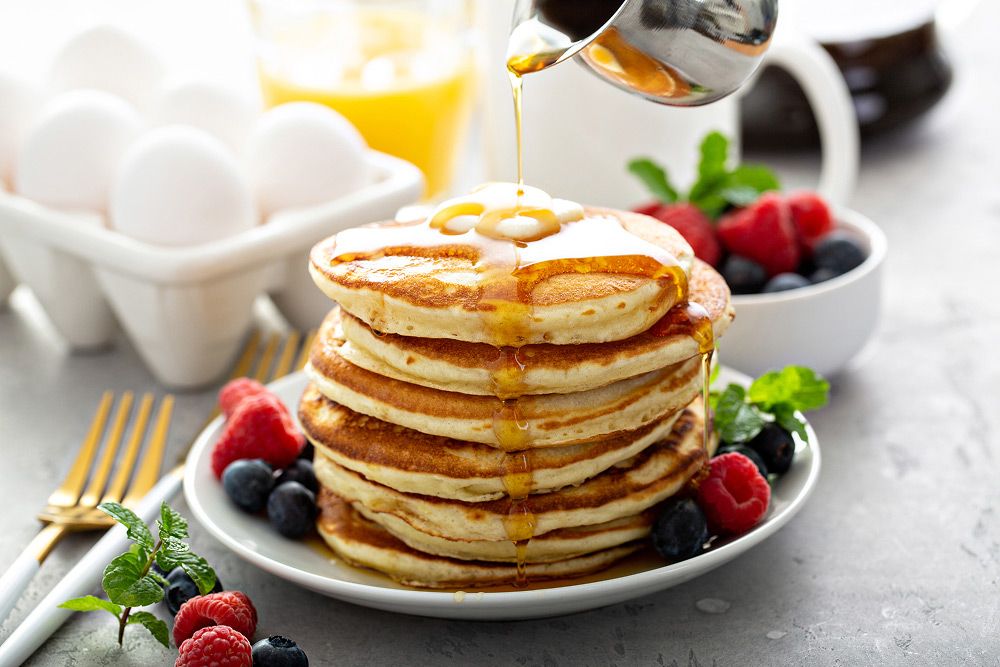Fluffy pancakes are a delicious breakfast option and fairly easy to whip up. That said, it can be a real downer to watch them fall flat, burn, or turn out dense as a result of mistakes in the prep or cooking process. However, these issues are completely avoidable. Mastering the science behind getting the ingredients right and learning the secret to making fluffy pancakes can help one get perfect results each time.
1. Use separate bowls
When making the pancake batter, one must mix the dry and wet ingredients in separate bowls first. Then, pour the wet into the dry to ensure even distribution of all the ingredients and prevent lumping.
2. Avoid overmixing
Overmixing the batter makes a huge difference to the final result and is often why some pancakes do not turn out fluffy. Mixing or agitating the flour excessively leads to gluten formation, resulting in a tough and chewy consistency and a rather unpleasant pancake-eating experience.
To avoid overmixing, one can use a whisk instead of a hand blender or stand mixer. One can then mix the ingredients by hand just until combined. It is normal to have a few lumps in the batter.
3. Use fresh ingredients
Pay attention to the freshness of the leavening agent used for the better. Most pancake recipes call for baking powder and/or soda. If these ingredients have been sitting in the pantry for six months to a year, they are less likely to help one make fluffy pancakes. So, one must always use fresh baking powder to get the pancakes to rise properly. According to the USDA, baking soda should be replaced six months after opening and baking powder after three months.
Bonus tip: To check the freshness of the baking soda, try doing a quick home test. Add a teaspoon of vinegar to a small amount of baking soda in a separate bowl. If it bubbles, it is good to use! If not, it’s time to replace it with a fresh batch. Similarly, to check the effectiveness of baking powder, one can mix a little boiling water with some baking powder. If the solution bubbles, it is good to use; if it doesn’t, replace it.
4. Use buttermilk
Instead of regular milk, one can use buttermilk to make the pancakes. While this may not be an ingredient most people have at home, it can easily be prepared with some common pantry ingredients. All it takes is some vinegar and milk.
This is a key secret behind fluffy pancakes because the acid in the buttermilk reacts with the baking soda to release carbon dioxide, which makes the batter rise, making the pancakes fluffy.
5. Prioritize getting the eggs right
While any other prep and batter-making tip will help one venture away from the unfluffy pancake territory, there is one major secret for getting restaurant-style fluffy pancakes every time. The trick lies entirely in the eggs.
To end up with thick, fluffy pancakes every time, start by separating the egg whites from the yolks. Transfer the whites and yolks each into separate bowls, and then whip up the egg whites to nice, stiff peaks. Beat enough air into the bowl until the whites take on a light meringue-like consistency. This can take around three to four minutes at medium speed. The process incorporates air into the egg whites, forming bubbles that expand while cooking, making the pancakes fluffy. The proteins in the egg whites also help stabilize these bubbles, making the pancakes light and airy.
Wait before adding the whipped whites to the batter. First, mix the rest of the pancake batter as usual. Don’t forget to combine the yolks as well. Once everything else is mixed, add the whipped egg whites to the bowl and fold gently. Do not mix it too much at this point, as it might take the air out of the batter, resulting in dense pancakes. If separating the egg yolks from the whites seems tricky, certain tried-and-tested tips may help.
- Use a sharp object like a knife to strike the egg and crack it into clean halves.
- Hold the two halves over a bowl and rock the yolk back and forth between the shells. Eventually, the yolk and the whites will separate (or the whites will drip down into the bowl below).
- Once separated, put the whites and the yolks in separate bowls.
6. Let the batter rest
After combining the ingredients, one doesn’t have to be in a rush to cook the pancakes immediately. Letting the batter rest allows the flour to fully hydrate and the leavening agents to activate. One can leave the batter for 1 to 15 minutes before starting the cooking process to achieve a lighter, fluffier consistency.
7. Don’t flip too soon
One must let bubbles develop after ladling the pancake batter onto the skillet. Rushing to turn the pancakes over will result in a deflated or scrambled pancake, which might not be that fun to eat. So, look for bubbling on top as a sign of cooking through, then turn it over.
8. Use consistent heat
Whether using an electric griddle or making pancakes on the stove, it is important to always use consistent heat. A cooking temperature of 350℉ to 375℉ is considered ideal. On a gas stove, keep the flame at medium or medium-low.
Perfecting the pancake recipe can take some time, so one must be patient. Taking some time to try different tips and techniques can help one determine what yields the lightest and fluffiest pancakes at home!
